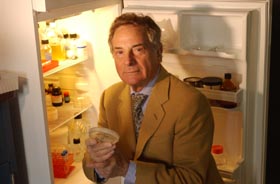|
This is an archived
article. For the latest news, go to the Advance Homepage
For more archives, go to the Advance Archive/Search Page. |
||
|
Health Center Biochemist
In response, Jay Glasel, an emeritus professor of biochemistry at the Health Center, proposed developing an inexpensive, easy-to-produ ce detector that would recognize and signal food pathogens and help protect the food supply from potential terrorism. "The food supply is especially vulnerable to terrorism," he says, "because the organisms that contaminate food are fairly easy to grow and introduce." In 1984, followers of Bhagwan Shree Rajneesh in Oregon used salmonella bacteria to poison salad bars in 10 restaurants in the Oregon town of The Dalles. It was the largest germ warfare attack in the U.S. history. Although the cult members apparently obtained the germ from a commercial supply house and had no special training, development of food-borne pathogens can be done using fairly simple microbiology, says Glasel. "Up to now, detectors have been cumbersome and expensive because they rely on antibodies, organic substances that are subject to environmental degradation from, say, light or heat," says Glasel. Food samples often have to be brought to fixed locations for testing. Glasel is trying to develop polymers, or plastics, that can detect specific pathogens but are cheap to produce and are less subject to environmental conditions. "These detectors could be portable, easily taken to restaurants or supermarkets where the food is sold or stored," he says. The process he is investigating is called molecular imprinting. Pathogenic bacteria usually have specific surface features that cause them to bind to host cells they attack. "We are trying to develop polymers imprinted with a shape specific to the pathogen we want to detect," says Glasel. Initially he and his group will focus on a single pathogen, E. coli O157:H7, but ultimately they hope to produce a panel or strip with multiple polymers, each of which could detect a different pathogen. The strip could be placed in packages of food and would give off a signal when the package was passed under the detector. The detector would be useful to both the military and the population at large. "The military is interested, especially for operations overseas where it buys its food locally and infiltration is relatively easy," says Glasel. "The public would be interested because it would be another safety feature that says the food is ok." Glasel's work is funded by Sensor Research and Development Corp. of Orono, Me., which received a $3.1 million grant from the government to develop leading-edge technologies to help combat terrorism. The company, which employs 44 people, currently develops sensors for chemical warfare agents. It has three scientists working on the project at the Health Center in space leased under the Small Business Incubator Program. The project is one of 40 funded by the government from the more than 14,000 proposals it received. The grant is for two years. Glasel says he hopes to develop a prototype detector by the end of that time. |
 espite the use
of salmonella as a weapon by a cult in Oregon in the 1980s, when it
sickened more than 700 people, the susceptibility of the nation's
food supply to germ warfare has been largely ignored - at least,
until 9/11. In the wake of that attack, government agencies dealing
with domestic security have been seeking solutions to various
terrorist threats, including the possible use of pathogens in
food.
espite the use
of salmonella as a weapon by a cult in Oregon in the 1980s, when it
sickened more than 700 people, the susceptibility of the nation's
food supply to germ warfare has been largely ignored - at least,
until 9/11. In the wake of that attack, government agencies dealing
with domestic security have been seeking solutions to various
terrorist threats, including the possible use of pathogens in
food.
